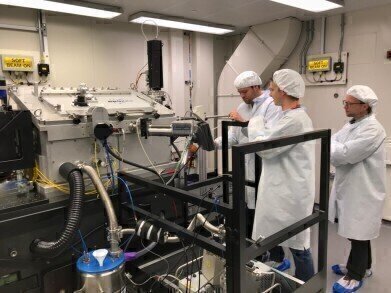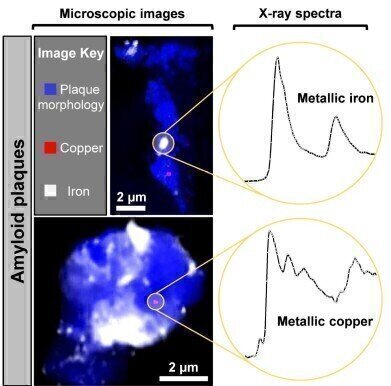-
 Researchers in the labs at Warwick University Credit: University of Warwick
Researchers in the labs at Warwick University Credit: University of Warwick -
 X-ray microscope images and x-ray absorption spectra obtained from two Alzheimer's disease plaque cores, measured at Diamond Light Source beamline I08. X-images showed the plaques to contain both iron and copper deposits. X-ray absorption spectra from the highlighted regions were consistent with metallic elemental iron (top spectrum) and copper (bottom spectrum) Credit: University of Warwick
X-ray microscope images and x-ray absorption spectra obtained from two Alzheimer's disease plaque cores, measured at Diamond Light Source beamline I08. X-images showed the plaques to contain both iron and copper deposits. X-ray absorption spectra from the highlighted regions were consistent with metallic elemental iron (top spectrum) and copper (bottom spectrum) Credit: University of Warwick
News
Understanding Alzheimer’s: are Metallic Elemental forms directly linked to Disease Progression?
Jun 21 2021
“Should the magnetic metals identified through this research be linked to the development of Alzheimer’s, they have a potential use as markers for disease diagnosis using techniques such as magnetic resonance imaging (MRI), allowing for pre-clinical disease screening of at-risk cohorts.” – James Everett
Nanoscale deposits of elemental metallic copper and magnetic elemental iron have, for the first time, been discovered in brain tissue of deceased Alzheimer’s patients by a UK-led team of scientists from the Universities of Warwick and Keele. Also working with the University of Texas at San Antonio (UTSA), the researchers conducted experiments at the UK’s Diamond Light Source and the Advanced Light Source in California (USA) to identify these metallic forms of iron and copper in ameloid plaques, which have distinctly different chemical and magnetic properties from their oxide forms.
Professor Joanna Collingwood, co-author and lead for the Trace Metals in Medicine Laboratory at the University of Warwick said:
“This is a fascinating and unexpected discovery, enabled by the sensitivity and precision of the synchrotron techniques we have used to study these human-brain-derived samples. We know that certain living systems can produce elemental forms of metals, so it will be important to discover if these arise from equivalent but previously undiscovered pathways in humans, or if the metallic forms arise as a direct consequence of disease.”
X-ray spectromicroscopy furthers understanding
Professor Peter Sadler, a medicinal chemist co-author at Warwick who specialises in research on metals in medicine, commented that:
“About 10 natural metals have roles in the brain. Studying their nano-speciation (their atomic chemical forms) in intact tissues is a major challenge. Our results show that synchrotron X-ray spectromicroscopy can reveal a totally new picture of metal neurochemistry that eventually might lead to new understanding of how the brain works and to new treatments for neurological conditions.”
Dr James Everett, a lead author from Keele University and an Honorary Fellow at Warwick, said: “Should the magnetic metals identified through this research be linked to the development of Alzheimer’s, they have a potential use as markers for disease diagnosis using techniques such as magnetic resonance imaging (MRI), allowing for pre-clinical disease screening of at-risk cohorts.”
The paper, ‘Biogenic metallic elements in the human brain?’, published in the journal Science Advances, was funded by the UKRI Engineering and Physical Sciences Research Council
Further information online
Digital Edition
Lab Asia Dec 2025
December 2025
Chromatography Articles- Cutting-edge sample preparation tools help laboratories to stay ahead of the curveMass Spectrometry & Spectroscopy Articles- Unlocking the complexity of metabolomics: Pushi...
View all digital editions
Events
Jan 21 2026 Tokyo, Japan
Jan 28 2026 Tokyo, Japan
Jan 29 2026 New Delhi, India
Feb 07 2026 Boston, MA, USA
Asia Pharma Expo/Asia Lab Expo
Feb 12 2026 Dhaka, Bangladesh


















